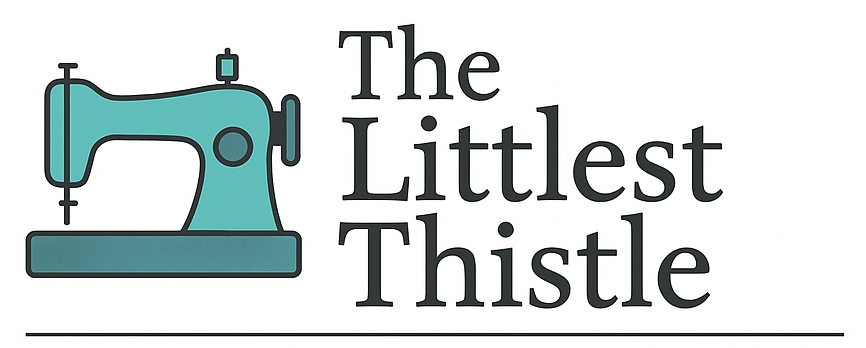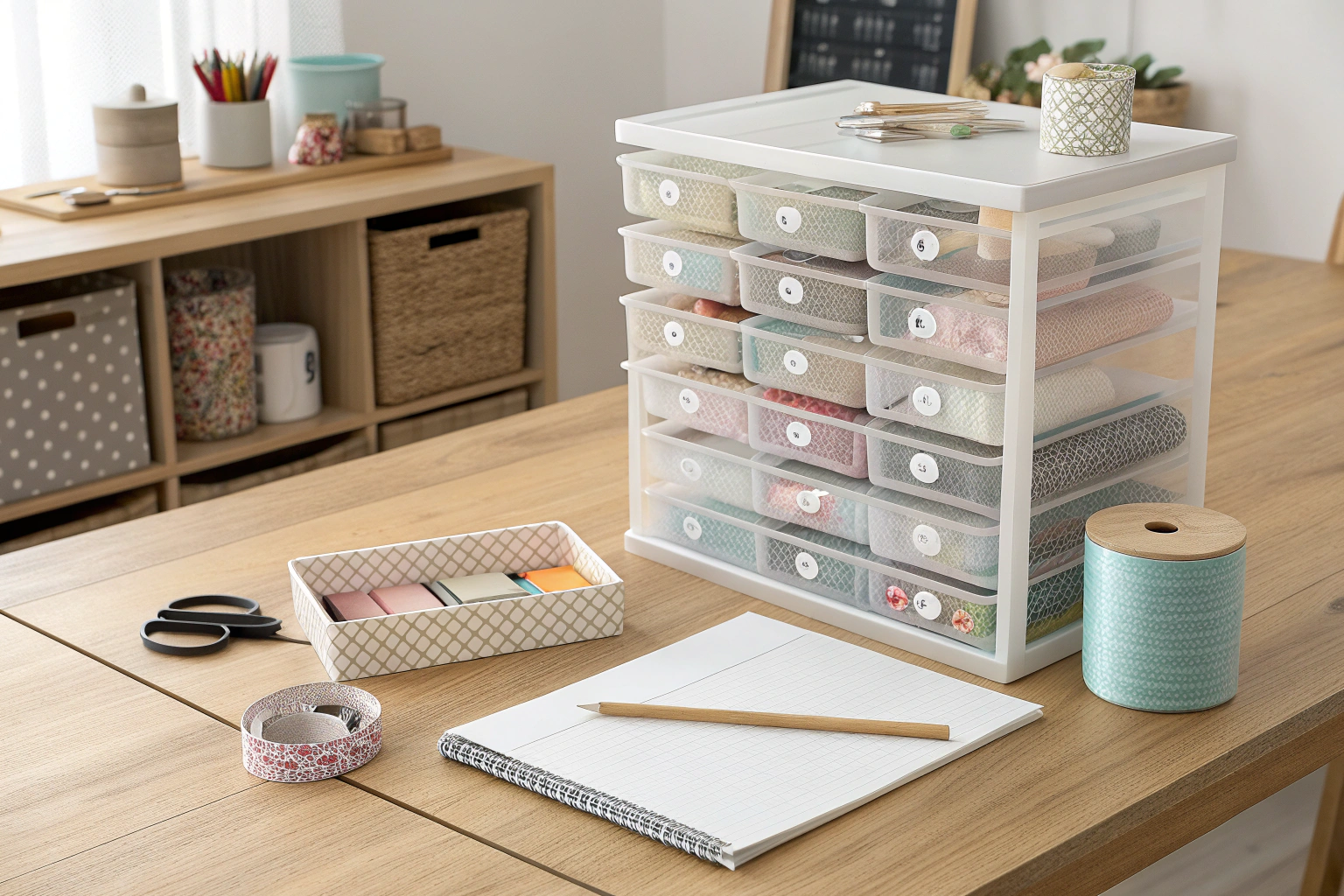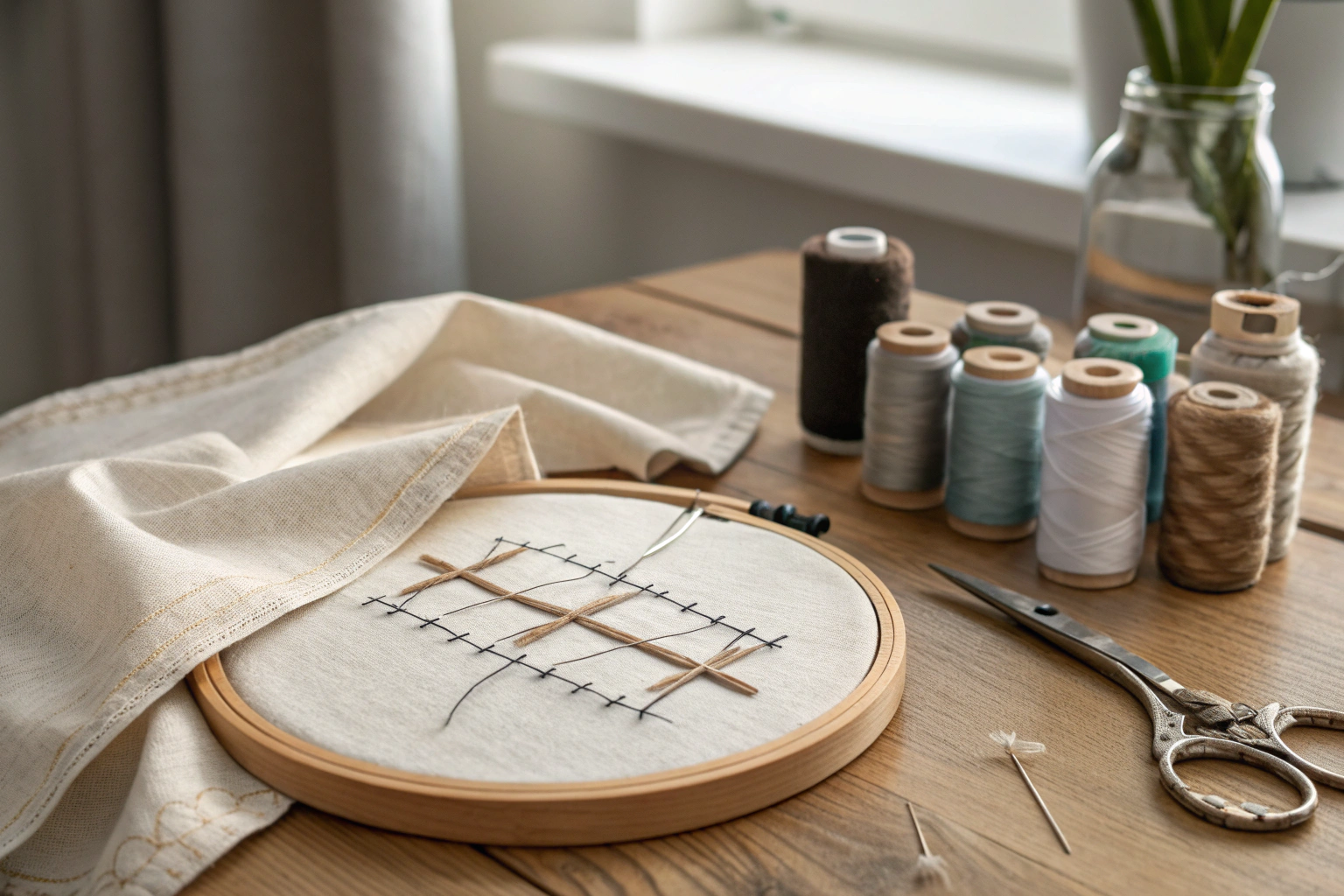Craft room organization ideas on a budget involve using everyday items and DIY solutions to neatly store supplies without spending a lot of money. The goal is to create a functional, inspiring space by transforming common objects like mason jars, tin cans, and shoeboxes into practical storage. This approach helps crafters manage clutter and find materials easily, making creative time more productive and enjoyable. This method avoids the high cost of custom-built or retail storage systems.
Key Benefits at a Glance
- Save Money: Drastically cut costs by repurposing household containers and shopping at dollar stores instead of buying expensive, specialized organizers.
- Improve Workflow: Find supplies in seconds with clear, categorized storage systems, reducing frustration and maximizing your creative time.
- Maximize Your Space: Utilize vertical storage solutions like pegboards, wall-mounted shelves, and over-the-door hangers to free up valuable desk and floor space.
- Simple and Accessible: Implement these ideas quickly using common items you already own, requiring no special skills or expensive tools to get started.
- Eco-Friendly Approach: Reduce waste and promote sustainability by upcycling materials such as glass jars, cardboard boxes, and plastic containers.
Purpose of this guide
This guide is for crafters, hobbyists, and DIY enthusiasts who want an organized, inspiring workspace without a hefty price tag. It solves the common problem of overwhelming craft supply clutter on a limited budget. You will learn simple, actionable steps to declutter and sort your materials, create custom storage using inexpensive items, and implement systems that are easy to maintain long-term. We’ll also cover common mistakes to avoid, such as buying containers before you’ve decluttered, helping you achieve a tidy and functional craft room for good.
Assessing Your Craft Space and Needs Before Spending a Dime
The foundation of any successful craft room organization lies not in the products you buy, but in understanding what you actually need. Craft Room Storage Solutions work best when they’re tailored to your specific supplies, space constraints, and crafting habits. Before spending a single dollar, take time to assess your current situation thoroughly.
Most crafters jump straight into purchasing bins, containers, and organizers without understanding their actual storage requirements. This approach often leads to mismatched systems, wasted money, and continued frustration. I learned this lesson the hard way when I spent $150 on beautiful matching containers that ended up being too small for my fabric stash and too large for my button collection.
The key is developing a systematic approach to craft supply inventory and workspace layout assessment. Start by examining your current supplies with fresh eyes, measuring your available space accurately, and identifying the specific pain points in your existing organization system.
- Document current supplies by category and frequency of use
- Measure available space dimensions and note constraints
- Identify pain points in current organization system
- Set realistic budget based on space size and needs
- Research storage solutions before purchasing anything
Understanding the relationship between your Craft Supplies and storage needs prevents costly mistakes. For example, if you primarily work with paper crafts, investing in deep bins designed for fabric storage makes little sense. Similarly, if you craft sporadically, elaborate organization systems may be overkill for your needs.
Organization planning should account for both current supplies and future growth. Consider which crafts you do most frequently and ensure those supplies are most accessible. Less frequently used items can occupy higher shelves or less convenient locations.
- Proper assessment prevents buying unnecessary storage products
- Understanding supply categories guides storage decisions
- Measuring space first saves money on wrong-sized solutions
- Most crafters can save 40-60% by planning before purchasing
The Smart Decluttering Method for Crafters Who Might Use It Someday
Craft room decluttering presents unique challenges that differ significantly from traditional minimalist approaches. Crafters see potential in nearly every item, making it difficult to part with supplies that might inspire future projects. The “I might use this someday” mentality creates overwhelming accumulation that standard decluttering advice doesn’t address.
The key difference lies in understanding that crafters need a modified approach that honors creativity while establishing practical boundaries. Unlike minimalists who aim to own fewer possessions overall, crafters need systems that accommodate the diversity of Craft Supplies while reducing organizational challenges.
I struggled with this myself, keeping every fabric scrap “just in case” and holding onto broken tools I promised to fix “someday.” The breakthrough came when I realized that keeping everything actually stifled my creativity because I couldn’t find what I needed when inspiration struck.
- DO keep supplies you’ve used in the past year
- DON’T keep broken items you haven’t fixed in 6 months
- DO donate duplicate tools in good condition
- DON’T feel guilty about letting go of unused gifts
- DO keep versatile supplies that work across multiple crafts
The organization_challenge attribute of craft supplies stems from their variety and sentimental value. However, strategic decluttering actually enhances creativity by making remaining supplies more accessible and visible. When you can see what you own, you’re more likely to use it.
Focus on frequency of use rather than potential future projects. If you haven’t touched something in over a year, it’s probably safe to let it go. This doesn’t mean becoming a minimalist—it means being strategic about what deserves precious storage space.
- Use the ‘one year rule’ for seasonal or specialty supplies
- Take photos of sentimental items before donating
- Start with obviously broken or expired supplies first
- Create a ‘maybe’ box to revisit in 3 months
Remember that decluttering creates space for better organization systems. Every item you remove is one less thing that needs storage, potentially eliminating the need for additional Storage Containers and saving money in the process.
Budget-Friendly Storage Furniture That Transformed My Craft Space
Furniture forms the backbone of effective Craft Room Storage Solutions, providing the foundation upon which all other organizational systems build. The right pieces can transform a chaotic craft space into an efficient workspace without breaking the bank. My own craft room transformation began with strategic furniture choices that cost under $200 total.
The secret lies in selecting versatile pieces that serve multiple functions while staying within reasonable cost ranges. A well-chosen Bookcase can provide vertical storage for bins, display space for inspiration, and even work surface area when positioned correctly. Similarly, a Desk with built-in drawers eliminates the need for separate storage purchases.
| Furniture Type | Cost Range | Best For | Durability |
|---|---|---|---|
| Bookcase | $30-80 | Vertical storage, bins | High |
| Rolling Cart | $25-60 | Mobile supplies, small spaces | Medium |
| Desk with Drawers | $50-150 | Work surface + storage | High |
| Cube Storage | $40-100 | Modular organization | Medium-High |
When shopping for budget furniture, timing and sourcing make enormous differences in final costs. Retail Stores offer different advantages depending on your needs and timeline. End-of-season clearances at major retailers often yield 40-60% savings on storage furniture.
- Thrift stores: 50-70% savings on solid wood furniture
- Facebook Marketplace: Best for specific pieces
- IKEA: Reliable budget options with modification potential
- Target clearance: End-of-season storage deals
My biggest transformation came from a $45 bookcase from a thrift store that I converted into a comprehensive storage system. With $20 worth of bins and labels, it now houses my entire paper crafting supply collection while displaying finished projects on the top shelves. This single piece replaced what would have been $200+ worth of specialized craft storage products.
The durability attribute becomes crucial when working with budget pieces. Look for solid wood construction or high-quality laminate that can withstand the weight of craft supplies. Avoid particle board furniture with craft supplies, as the weight often causes sagging or structural failure.
Repurposing Existing Furniture for Craft Storage My Success Stories
DIY Projects offer the ultimate budget solution for craft room organization, often costing under $50 while providing customization opportunities that commercial products can’t match. The key lies in seeing potential in furniture pieces you already own or can acquire inexpensively.
My most successful repurposing project transformed an old kitchen hutch into a paper storage center. The original piece cost $25 at an estate sale and needed only $15 worth of adjustable shelving to become the perfect solution for storing cardstock, scrapbook papers, and finished albums. The glass doors protect supplies from dust while keeping everything visible and accessible.
| Original Furniture | New Function | Modification Cost | Time Required |
|---|---|---|---|
| Kitchen hutch | Paper storage center | $15 | 2 hours |
| TV stand | Fabric storage | $8 | 1 hour |
| Dresser | Tool organization | $25 | 3 hours |
| Bookshelf | Supply display | $12 | 1.5 hours |
Another success story involved repurposing an old TV stand for fabric storage. The enclosed cabinet design protects fabrics from dust and fading, while the open shelving above displays current projects and inspiration. Simple drawer dividers made from cardboard cost only $8 and created perfect compartments for different fabric types.
However, not every repurposing attempt succeeds. I once tried converting a narrow bookshelf into ribbon storage by adding dowel rods between shelves. The spacing was wrong, ribbons tangled constantly, and the whole system became frustrating to use. This failure taught me to thoroughly plan modifications before starting and to consider how the finished system will function in daily use.
“Repurposing common household items for craft room organization—such as glass jars for buttons and small containers for odds and ends—allows crafters to maximize storage without expensive purchases. In our latest survey, 81% of crafters reported using at least one thrifted or upcycled organizer to cut costs.”
— The Graphics Fairy, March 2024
Source link
The enhances relationship between DIY projects and Craft Room Storage Solutions becomes evident when customization meets specific needs. Commercial storage rarely offers the exact dimensions or features needed for unique spaces or supply collections. Repurposing allows you to create solutions that fit perfectly while staying within minimal budgets.
IKEA Hack Projects for Craft Rooms
IKEA furniture provides exceptional modular storage opportunities with price points ranging from $5 to $50 for most craft-relevant pieces. The Swedish retailer’s design philosophy emphasizes functionality and customization, making their products ideal candidates for craft room modifications.
| IKEA Product | Base Price | Hack Cost | Best For |
|---|---|---|---|
| Kallax shelf | $40 | $10-20 | Cube storage with bins |
| Alex drawers | $80 | $15-25 | Small supply organization |
| SKÅDIS pegboard | $15 | $5-15 | Wall-mounted tool storage |
| Raskog cart | $50 | $8-12 | Mobile craft station |
The Kallax shelf system exemplifies IKEA’s approach to craft room organization. The basic 4-cube unit costs $40 and accepts standard storage bins perfectly. Simple modifications like adding casters for mobility or installing LED strip lighting for better visibility cost under $20 and dramatically improve functionality.
- Choose IKEA piece based on your specific storage needs
- Gather basic tools: drill, screws, paint or contact paper
- Plan modifications before assembly for easier customization
- Test functionality before final installation
Alex drawer units offer another excellent hacking opportunity, particularly for small supply organization. The standard unit includes nine drawers perfect for storing buttons, ribbons, and other small items. Adding clear acrylic dividers costs about $15 and creates customized compartments for different supply types.
“Cube organizers remain one of the most affordable and customizable solutions for budget craft room setups, with nearly 70% of respondents recommending modular cube systems for maximizing limited space.”
— The Country Chic Cottage, April 2024
The SKÅDIS pegboard system deserves special attention for tool storage. At $15 for a large board, it provides wall-mounted organization that keeps frequently used tools visible and accessible. Various hooks and containers designed for the system cost $2-8 each and create customized storage for scissors, rulers, and other tools.
Clever Organization Systems by Craft Type
The diversity of Craft Supplies creates unique organization challenges that generic storage solutions cannot address effectively. Different crafting mediums require specialized approaches based on supply characteristics, usage patterns, and preservation needs. Understanding these requirements prevents costly mistakes and ensures your organization system actually improves your crafting experience.
One-size-fits-all approaches fail because they ignore the fundamental differences between craft types. Sewing supplies need protection from dust and moisture, while paint requires temperature-stable upright storage. Paper crafts demand flat, visible organization, and jewelry making needs compartmentalized small-item storage.
- Sewing supplies need protection from dust and moisture
- Paint requires temperature-stable, upright storage
- Paper crafts demand flat, visible organization
- Jewelry making needs compartmentalized small-item storage
- Fabric crafts benefit from rolled or folded visibility systems
The relationship between Craft Room Storage Solutions and specific craft types becomes crucial when designing systems that accommodate multiple mediums. Successful multi-craft organization requires adaptable solutions that can evolve with changing interests and project types.
For more practical advice, consult the organize a craft room guide or review reducing waste suggestions for eco-friendly and budget-friendly organization.
Consider how different crafts intersect in your practice. Many quilters also scrapbook, using similar cutting tools and rulers. Jewelry makers often work with beads and wire that require similar small-compartment storage. Identifying these overlaps helps create efficient systems that serve multiple purposes.
The key lies in establishing primary zones for each craft type while creating flexible secondary storage for shared supplies. This approach maximizes efficiency while maintaining the specialized storage each craft type requires.
Paper Craft and Scrapbooking Organization on a Shoestring
Scrapbooking presents unique storage challenges centered on paper storage needs and visibility importance. Unlike many other craft supplies, paper products require flat storage to prevent curling and creasing, while maintaining easy access for project inspiration and selection.
The challenge intensifies with the variety of paper types, sizes, and weights involved in modern scrapbooking. Cardstock, patterned papers, vellum, and specialty papers each have different storage requirements, yet they need to work together in a cohesive system that doesn’t break the budget.
| Storage Method | Cost | Pros | Cons |
|---|---|---|---|
| Vertical file system | $15-25 | Easy access, prevents bending | Limited capacity |
| Flat drawer storage | $40-80 | Maximum protection | Expensive, space-consuming |
| Magazine holders | $8-15 | Budget-friendly, visible | Papers can slide |
| Paper towers | $25-45 | High capacity, organized | Requires floor space |
My most successful paper organization solution combines vertical file storage with clear containers for embellishments. Magazine holders from the dollar store, at $1 each, store cardstock by color family while maintaining visibility. This system solved my biggest pain point: spending twenty minutes searching for the perfect shade of blue cardstock that I knew I owned.
- Store cardstock vertically like files for easy browsing
- Use clear containers for small embellishments to maintain visibility
- Label everything with both words and color coding
- Keep frequently used papers at eye level
The visibility aspect cannot be overstated in paper craft organization. When supplies are hidden in opaque containers or buried in drawers, they effectively don’t exist for creative purposes. Clear Storage Containers cost only slightly more than opaque versions but dramatically improve supply utilization and project inspiration.
Small embellishments present their own organizational challenges, requiring systems that prevent loss while maintaining visibility. Tackle boxes designed for fishing supplies often provide the perfect solution at a fraction of the cost of craft-specific storage. A $12 tackle box with adjustable compartments can organize hundreds of small embellishments while fitting perfectly on standard shelving.
Frequently Asked Questions
How do you organize a cluttered craft room?
Start by decluttering your craft room, sorting items into categories like tools, materials, and supplies, and discarding anything unused. Use storage solutions such as shelves, bins, and drawer organizers to keep everything in its place, ensuring easy access. Label all containers clearly to maintain order and make future projects more efficient.
How to set up a craft area in a small space?
Choose a compact, multifunctional workspace like a foldable table or wall-mounted desk to maximize floor space in your small craft area. Incorporate vertical storage with pegboards, shelves, and hanging organizers to store supplies without cluttering the floor. Prioritize essential tools and materials, using stackable bins to keep everything organized and accessible.
What furniture is best for craft room organization on a budget?
Affordable options like plastic drawer units or second-hand bookshelves work well for budget craft room organization, providing ample storage for supplies. Rolling carts are great for mobility and can be found inexpensively at discount stores. Look for modular furniture that can be customized to fit your space without breaking the bank.
How can I repurpose household items for craft storage without spending money?
Reuse empty jars, shoeboxes, and egg cartons as free storage for small craft items like buttons, beads, and threads. Old mugs or tin cans can hold pens, brushes, and scissors, while cardboard boxes can be transformed into drawer dividers. This approach not only saves money but also adds a personalized touch to your craft space.





